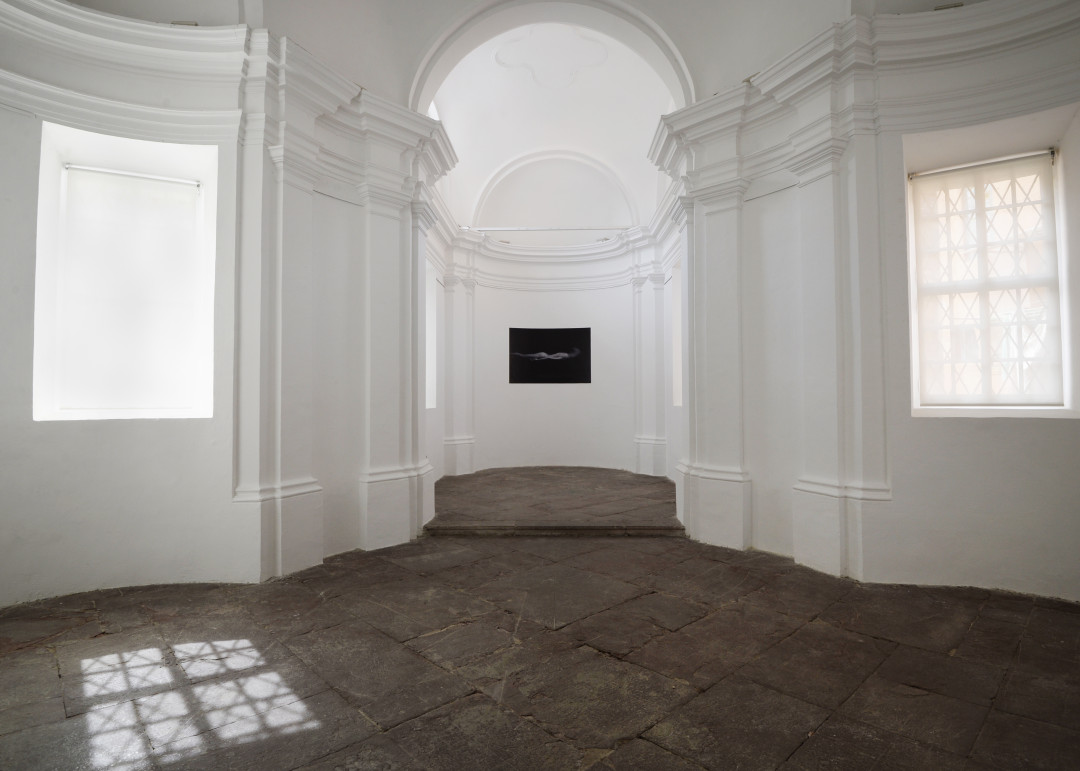The exhibition Illusion of Life takes the viewer into a meditative experience, visual and auditory, through a minimalist presentation of the artist’s idea, where he can reconsider man, the world and his role in it. Irena Jurca places art photography in the foreground of her interest and uses it to address a variety of subject matters. As she says herself, the photographic image enables her to explore the relationship between an intimate experience of the world and the social reality outside of that. She focuses on topics that consider the experience of life as well as various existential questions about meaning and essence, transience and understanding of social reality. In her preceding series Sea in Me, she dealt with the socio-political problem of migration, which was related to the concrete experience of the refugee crisis, as it is also felt in Slovenia. In the Endless Dream series, however, she has focused on the individual, surrounded by a culture of fear, fragility and fragmentation.
Through the use of minimal pictorial means: low light, blurriness and a black background, which helps to create the impression of emptiness, the artist responds critically to the contemporary times. Bodies embraced by blackness and animals trigger feelings of discomfort and danger, emphasising the fragility of the photographed creatures. The exhibition Illusion of Life features the photographic works from the Endless Dream series in dialogue with an audio recording of breathing. The staged photographs depict the floating body, parts of the body, floating jellyfish and smoke, which winds into the associative form of Goya’s painting of Saturn devouring his son.
Reading art is always multifaceted and requires a certain amount of prior knowledge that enables the viewer to ingest and understand it through interpretation, which depends on the respective cultural and historical circumstances. The portrayed motifs can be linked to the figures from Greek mythology and the exhibition can be interpreted through them. These include the Gorgon Medusa – the female principle, which can be recognised in the representation of the floating animals. The appearance of the jellyfish, or medusa, on the black ground intensifies our gaze, arouses the wonder of the beauty of this marine animal, and at the same time reminds of its stinging touch. The five jellyfish at different stages of movement indicate the unification of the male and female principle, as well as the movement between the active and the passive mode of operation. The male principle embodied by Saturn is portrayed in the photograph of smoke, where the molecular structure is composed into a visually recognisable bodily form. The two mentioned mythological figures in the myth meet only indirectly. Perseus killed Medusa with the same sickle weapon (hárpē) that was also used by Saturn (the Greek Cronos) to castrate Uranus’ father and succeed to the power of the world. Pegasus and Chrysaor were born from Medusa’s severed head, whereas the Erinyes, the Giants and Aphrodite the goddess of love came forth from the seed and blood of Uranus. Their death or mutilation generated new life. However, Saturn was not spared either. It was foretold that his own children would deprive him of his authority. The fear of losing power pushed him into infanticide and cannibalism. With growing differences within society, the insatiable affluence of the handful and the consequent increase in poverty, we are losing faith in a society that is supposed to take care of the individual. The opposite is taking place, the struggle for survival is leading us into rivalry, disregard and degradation, we are becoming a society that is swallowing itself and sinking into nihilism.
Irena Jurca’s photographs reflect anxiety as they place human corporeality, built from skeletal architecture, and the fragile, gelatinous structure of the jellyfish, that can be perforated by the smallest point, into a relationship. Our narcissistic culture has canonised its corporeality in the chiselled Apollos and later Davids. It has cast the measure of perfection into indestructible bronze. Yet, despite our sturdier structure, we are not far removed from the simple creatures like the jellyfish, and our bodies cannot compete with the eternal quality of stone and metal. We have created ideals that we cannot achieve.
By displaying a fragile and fragmented body, the artist crumbles her thought into the weighty issues of the present time; what does it mean to be human, how much humanity has been retained in the struggle for survival and what is yet to come? Behind the thick silent walls of the former sacral building, we can listen to the barely audible sound installation of someone else’s breathing, who enters into the viewer’s intimate space and begins to dictate his rhythm of inhale and exhale. Breathing, the basic automatic bodily function, enables life and connects us with others. But perhaps being human means re-establishing our relationship with nature, fellow man and other creatures with whom we share a place on Earth.
The meditative nature of the exhibited works poses the assertion as a question: dum spiro spero?
Text: Nina Sotelšek
Biography
Irena Jurca was born in 1977 in Ljubljana. She completed the Secondary School of Design and Photography in Ljubljana, specialising in photography. Later, she graduated in Cultural Studies from the Faculty of Social Sciences. She completed the School of Photography Criticism and published reviews of photographic exhibitions and books in Fotografija magazine. She attended the “Masterclass” photographic workshop under the tutelage of Klavdij Sluban with other selected photographers. She has held solo shows at KUD France Prešeren, Galerija Fotografija and Galerija stolp Škrlovec. She lives and works in Ljubljana.
